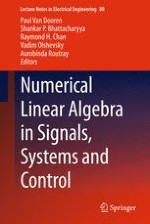The purpose of Numerical Linear Algebra in Signals, Systems and Control is to present an interdisciplinary book, blending linear and numerical linear algebra with three major areas of electrical engineering: Signal and Image Processing, and Control Systems and Circuit Theory. Numerical Linear Algebra in Signals, Systems and Control will contain articles, both the state-of-the-art surveys and technical papers, on theory, computations, and applications addressing significant new developments in these areas. The goal of the volume is to provide authoritative and accessible accounts of the fast-paced developments in computational mathematics, scientific computing, and computational engineering methods, applications, and algorithms. The state-of-the-art surveys will benefit, in particular, beginning researchers, graduate students, and those contemplating to start a new direction of research in these areas. A more general goal is to foster effective communications and exchange of information between various scientific and engineering communities with mutual interests in concepts, computations, and workable, reliable practices.
